I've run small K's the other way - with the speakers' central axis pointing towards the center of the room as in "7" below - that can be helpful with fullrange whose treble power response is more limited than usual.
An externally hosted image should be here but it was not working when we last tested it.
Last edited:
After listening to it sideways for about 4 hrs I went back to vertical orientation. I like it better as the off axis response is better and it is uniform when I walk around my speaker lab to work. These are excellent lab speakers when you need to move about. Listening to Sting's "Ten Summoner's Tales - an excellent CD to go with this speaker. Actually, almost everything sounds good on it - well haven't tried symphonic yet, doubt that will work though.
may work for opera reasonably well for a little speaker depending upon the mic perspective on the orchestra vs soloists and chorus-- think about the best affordable K system you can concoct with your present knowledge and experience be it 2 or more way to handle the full range of recorded spl. I would probably use a K-tube on top assuming good coaxial not available. K15 would not be shabby as run in 1952 with good 15cx. I don't know what to use if the system employed a K-midrange - it should be sensitive and pretty smooth. Think of Romy the Cat's horn system in concept but with K and severe cost and implementation compromises. Would the K system survive against a decent FLH system? (I think "maybe" depending upon room size and listener's distance from the rig)
the apertures on these little Karlsonators are small enough to really work in the treble allowing excellent horizontal dispersion with little timbre change off axis. Sideways as in position "7" in the Karlson brochure above can be useful with weaker treble fullrange and when the listener is fixed in one spot.
the apertures on these little Karlsonators are small enough to really work in the treble allowing excellent horizontal dispersion with little timbre change off axis. Sideways as in position "7" in the Karlson brochure above can be useful with weaker treble fullrange and when the listener is fixed in one spot.
Last edited:
No, I haven't before but I will give it a shot. You mean like this? The K-apertures work their polar magic when oriented vertically. Initial impression is that the central phantom image is more powerful in side orientation but sweet spot is smaller and walking around the room the phantom image is not as stable. I will give it a day or two in this configuration though. Doesn't sound bad at all though - surprising actually.
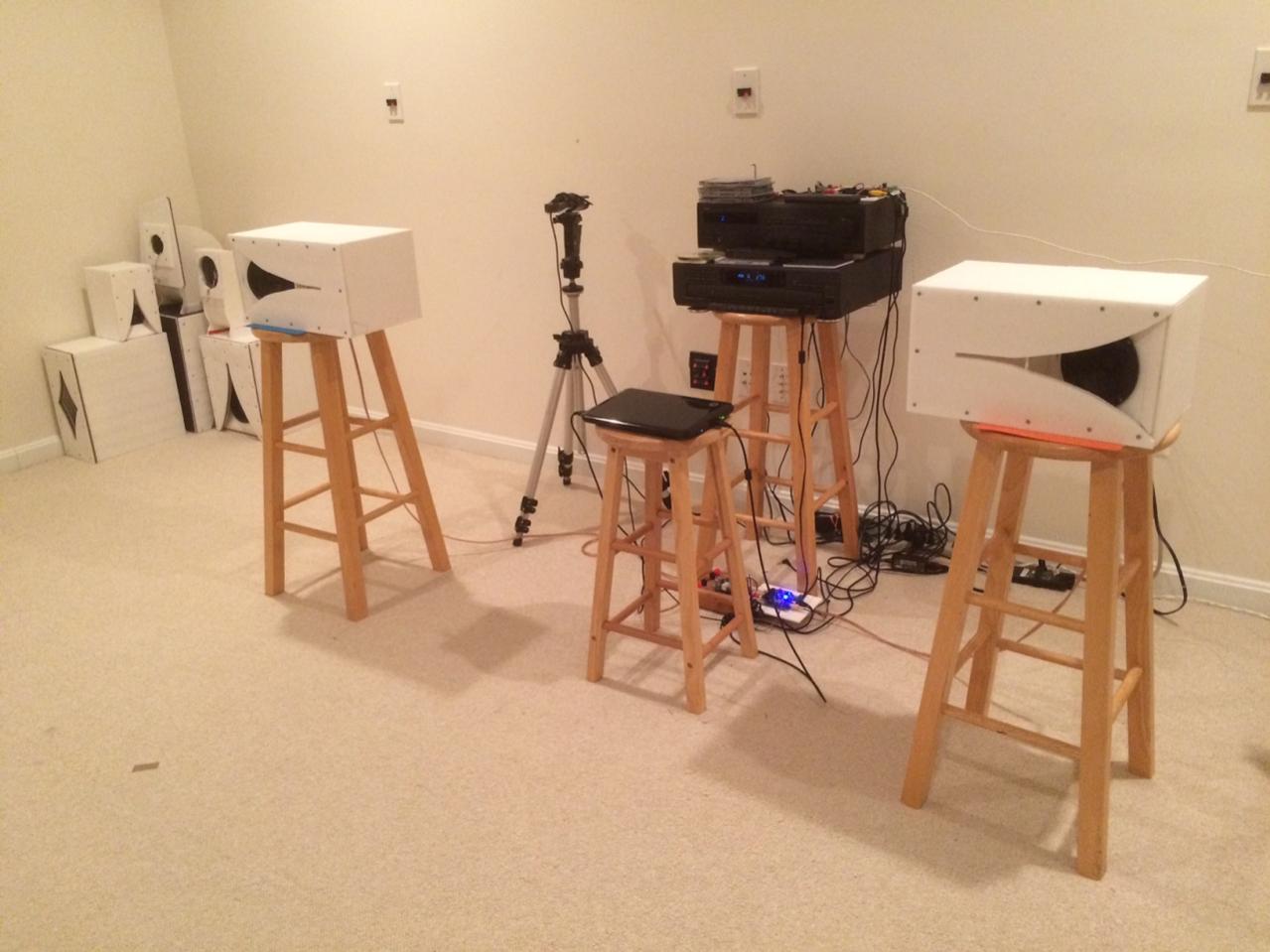
yes with the aperture in that position but I always toed them in toward the listening position and tried to keep an equal triangle of width apart and distance to listening spit in centre.
Hey guys, I feel like I'm kinda late to the party, but I wanted to share some of my work with the 0.4X Karlsonator design. I was creating documentation for my build and I figured it couldn't hurt to do a modal analysis on my enclosure model. I started by estimating the material properties by taking a scrap of foam board (the dollar store stuff) and measuring deflection with a known weight in a simply supported beam setup. Then I estimated density by weighing 6 full sheets. I suspect my frequencies could be off by up to 20% given the accuracy of my measurements. Please keep in mind when looking at the results that amplitude in these is meaningless, so it can't be compared between results plots. All the plots are in an iso view and show the half of the box facing the screen in outline only so the inside features can be seen clearly. In all cases shown the enclosure movement is symmetrical (although in one case it's in anti-phase, but you can see it), so you're not missing anything by not being able to see the plot of the transparent part. I also did not model in the driver. This seemed like a lot of unneeded work since the biggest problem for the enclosure is the front baffle.
I started with the standard enclosure without the aperture brace to see what the brace does. The first three modes were all the front baffle flapping around. Modes at 145, 170, and 245 Hz.
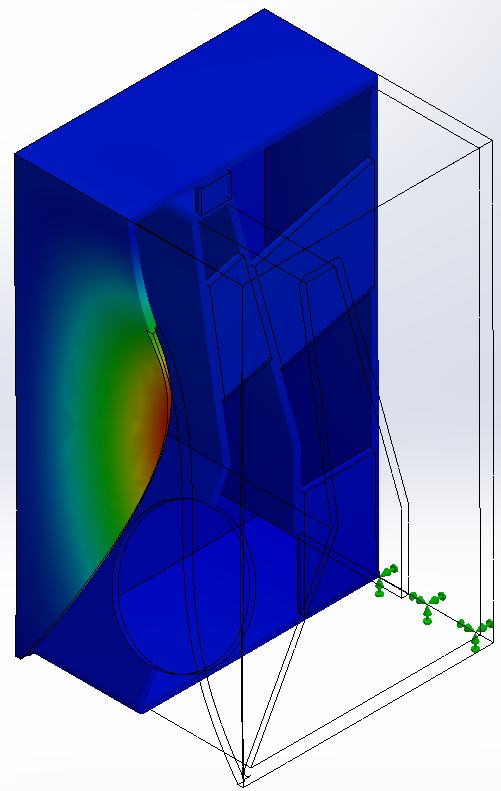
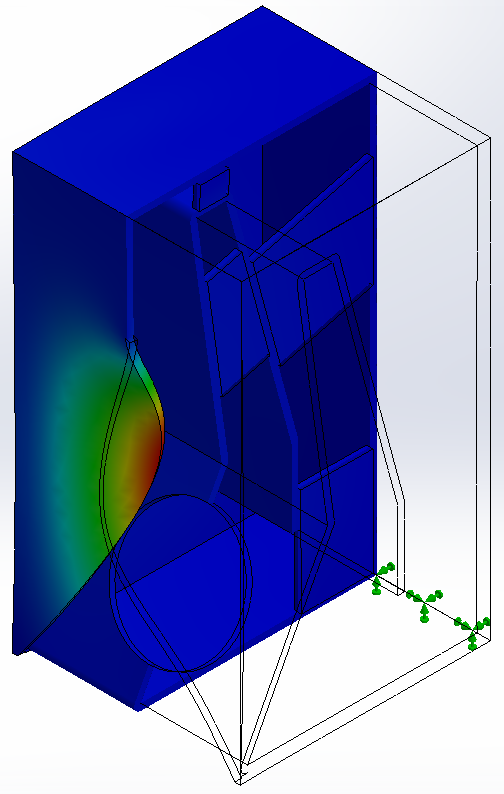
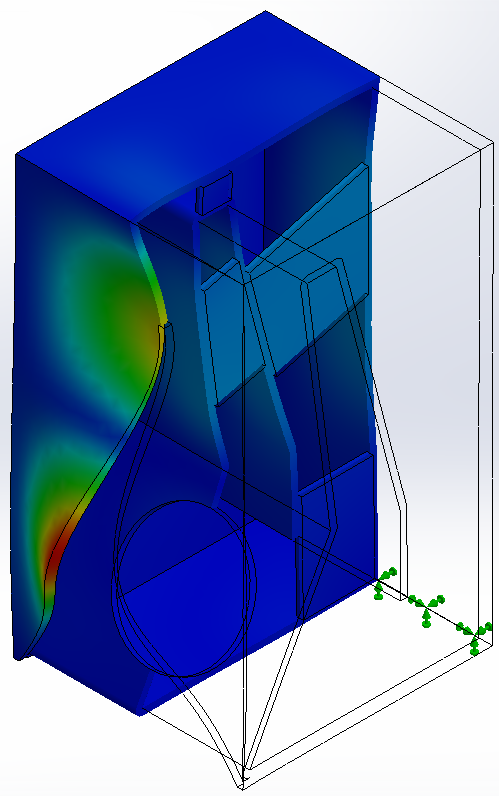
Next, I added the brace as described, 0.75 inches wide, at the deepest part of the front chamber (about 4.75 inches up from the bottom). The first mode is still the front baffle, but now it's at 183 Hz, and the next couple modes are the enclosure. The first enclosure mode is at 247 Hz, shown for reference. That's a great improvement.
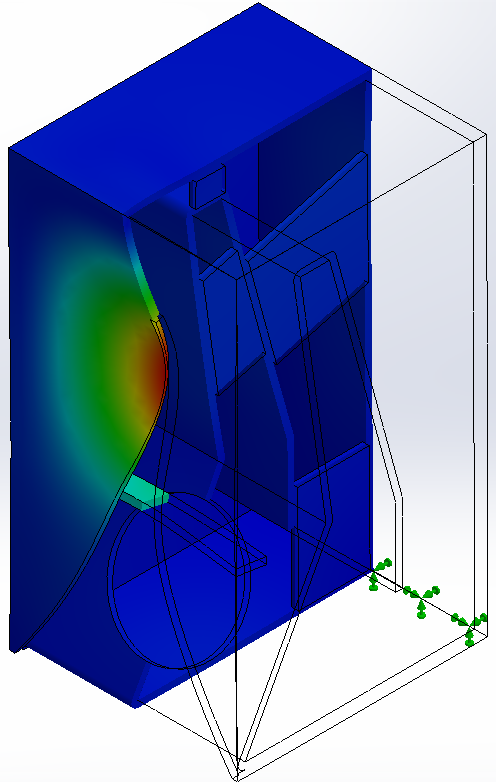
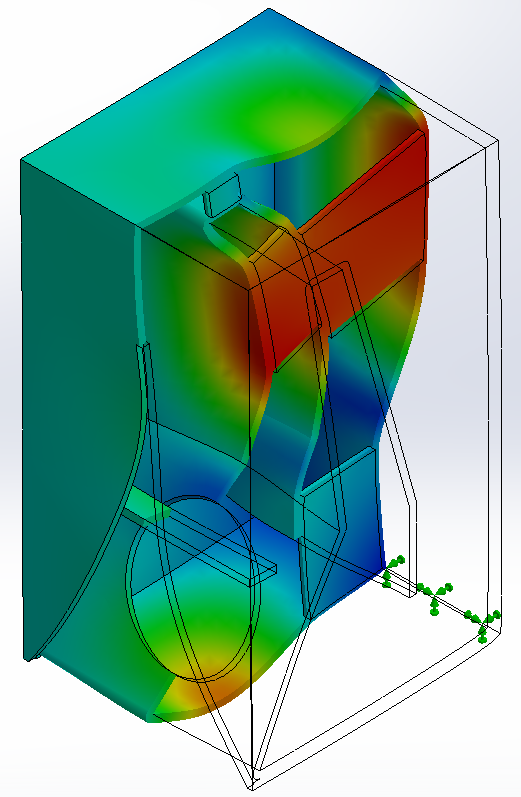
From these plots, I thought there could be some further improvement from moving the brace up. Not sure if this impacts acoustics much, but the brace was most effective at 6.4 inches up from the bottom. This increased the first mode from 183 Hz to 226 Hz.
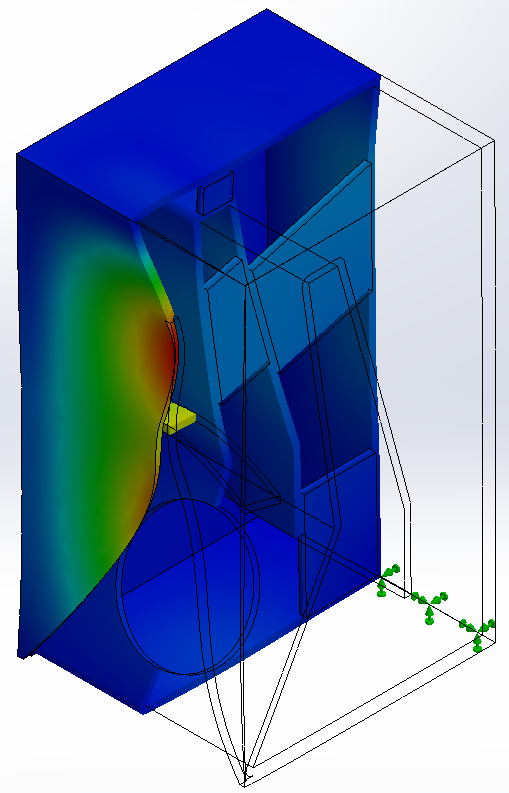
Finally, it looked like the aperture could be further improved by adding a stiffener at the upper edge. Might be complicated to add this if you wanted a removable front, but it seemed like it might be worth trying. I also re-optimized the position of the aperture brace (this time at 5.5 inches up) and the result was a first mode of 255 Hz, an improvement of 29 Hz.
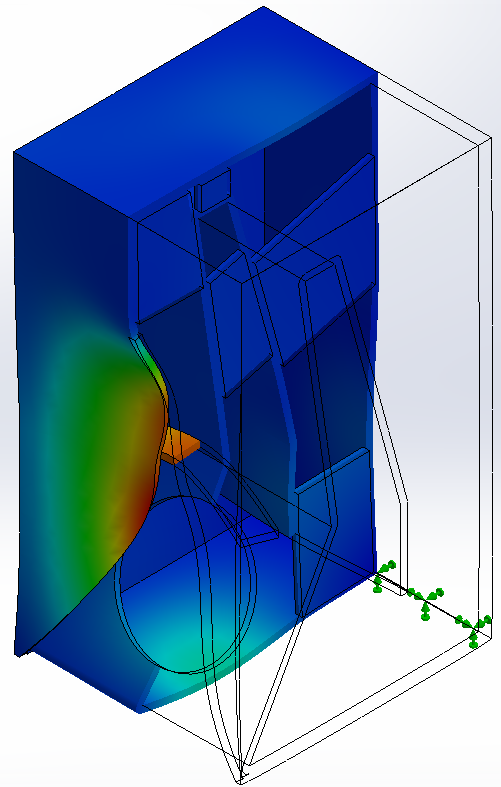
Doubling the thickness of the front baffle did not change things very much and did not seem like a good option. However, this type of analysis only indicates frequency, so including a damping layer (as XRK has suggested) may still be very effective.
I hope all that is at least interesting, if not possibly useful for bracing improvements. I'll share my version of the documentation when it's ready. May take some time since I tend to only get half an hour here or there to work on it.
I started with the standard enclosure without the aperture brace to see what the brace does. The first three modes were all the front baffle flapping around. Modes at 145, 170, and 245 Hz.
Next, I added the brace as described, 0.75 inches wide, at the deepest part of the front chamber (about 4.75 inches up from the bottom). The first mode is still the front baffle, but now it's at 183 Hz, and the next couple modes are the enclosure. The first enclosure mode is at 247 Hz, shown for reference. That's a great improvement.
From these plots, I thought there could be some further improvement from moving the brace up. Not sure if this impacts acoustics much, but the brace was most effective at 6.4 inches up from the bottom. This increased the first mode from 183 Hz to 226 Hz.
Finally, it looked like the aperture could be further improved by adding a stiffener at the upper edge. Might be complicated to add this if you wanted a removable front, but it seemed like it might be worth trying. I also re-optimized the position of the aperture brace (this time at 5.5 inches up) and the result was a first mode of 255 Hz, an improvement of 29 Hz.
Doubling the thickness of the front baffle did not change things very much and did not seem like a good option. However, this type of analysis only indicates frequency, so including a damping layer (as XRK has suggested) may still be very effective.
I hope all that is at least interesting, if not possibly useful for bracing improvements. I'll share my version of the documentation when it's ready. May take some time since I tend to only get half an hour here or there to work on it.
Attachments
-
 Karlsonator Mode 1 (145Hz)-No Front Brace.png77.8 KB · Views: 923
Karlsonator Mode 1 (145Hz)-No Front Brace.png77.8 KB · Views: 923 -
 Karlsonator Mode 2 (170Hz)-No Front Brace.png73.5 KB · Views: 930
Karlsonator Mode 2 (170Hz)-No Front Brace.png73.5 KB · Views: 930 -
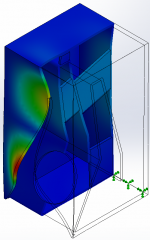 Karlsonator Mode 3 (245Hz)-No Front Brace.png105.1 KB · Views: 913
Karlsonator Mode 3 (245Hz)-No Front Brace.png105.1 KB · Views: 913 -
 Karlsonator Mode 1 (183Hz)-Front Brace @4.75.png85.6 KB · Views: 910
Karlsonator Mode 1 (183Hz)-Front Brace @4.75.png85.6 KB · Views: 910 -
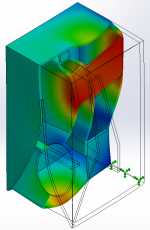 Karlsonator Mode 2 (247Hz)-Front Brace @4.75.png152.8 KB · Views: 929
Karlsonator Mode 2 (247Hz)-Front Brace @4.75.png152.8 KB · Views: 929 -
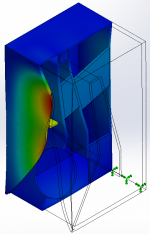 Karlsonator Mode 1 (226Hz)-Brace@6.4.png105.7 KB · Views: 904
Karlsonator Mode 1 (226Hz)-Brace@6.4.png105.7 KB · Views: 904 -
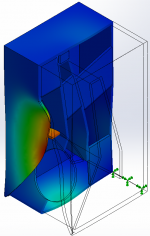 Karlsonator Mode 1 (255Hz)-Brace@5.5+Top Brace.png98.3 KB · Views: 905
Karlsonator Mode 1 (255Hz)-Brace@5.5+Top Brace.png98.3 KB · Views: 905
Yes very nice work. Thank you ! What software are you using?
Thanks guys. That was done with SolidWorks Simulation. Makes it easy to use the same model for simulation and drawings.
Oh great. I use SW and never thought to use it for modal analysis. Does modal analysis come with the standard install (not the highest)? Looks like a great tool for DML design and analysis.
Oh great. I use SW and never thought to use it for modal analysis. Does modal analysis come with the standard install (not the highest)? Looks like a great tool for DML design and analysis.
No, the standard version doesn't come with stimulation. I think it may come with a "light" version of stress, but I haven't used it. Modal analysis comes with the second upgrade of simulation. I use it for work all the time since we have to design to tolerate high vibration environments.
What does DML stand for?
Big flat panel speakers. Distributed mode loudspeaker - Something I am just starting to revisit again as foam core is the ideal material for a DML panel.
would a diy DML be made something like the Polyplanar I bought in the 1960's sans decoupling rings? (this particular model was a bit tinny due to the aluminum cap - I even had it in a 5 cubic foot reflex tuned with aperiodic holes -lol)




Big flat panel speakers. Distributed mode loudspeaker - Something I am just starting to revisit again as foam core is the ideal material for a DML panel.
Oh wow, I'm going to need to read up on those.
If you have a design you'd like a modal analysis of, I'd be willing to run it.
There are some old post in FC thread:
http://www.diyaudio.com/forums/full-range/223313-foam-core-board-speaker-enclosures-235.html#post3911437
Unahm and Philfr did some stuff. I know CLS is the master of this stuff if he would post links to his multiway DML behemoths.
Mudjester, thanks for the offer. Let me see if I can come up with something.
http://www.diyaudio.com/forums/full-range/223313-foam-core-board-speaker-enclosures-235.html#post3911437
Unahm and Philfr did some stuff. I know CLS is the master of this stuff if he would post links to his multiway DML behemoths.
Mudjester, thanks for the offer. Let me see if I can come up with something.
Last edited:
cool ! - I've never seen CLS' DML stuff - it is related to Poly-planar - here's a link
NXT.......rubbish??....THINK AGAIN!
NXT.......rubbish??....THINK AGAIN!
I think CLS has posted this image of his slot loaded open baffle dominated listening room before - the huge thing up front and center is a DML.

That audiocircle thread is huge but if you have time - there is good stuff in there. I haven't had more time than to quickly glance at it.

That audiocircle thread is huge but if you have time - there is good stuff in there. I haven't had more time than to quickly glance at it.
Last edited:
that's pretty big - - hoping CLS' upcoming KaZba will be a worthy contender to his SLOB - I need a bigger room - a warehouse would be a start😀 - I don't see any K-tubes - maybe a little K topped with K-tube & compression driver would make a nice project for CLS
these don't look tiny
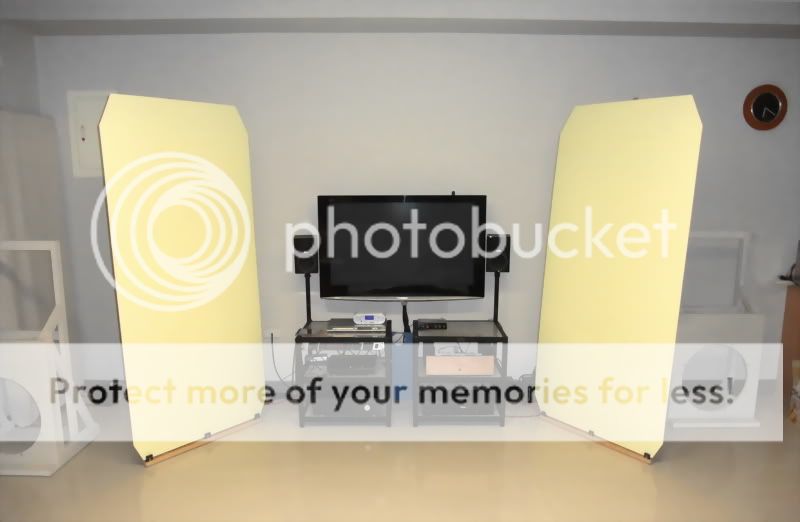
my Karlsonator 12s lack bracing - about all I can do is to brace the back then run dowel strut
to the wings - being made of 3/4" "Arauco", they're reasonably rigid.
the internal vent and initial aperture region on regular K are both sensitive and sometimes need to be tuned
"by ear" to taste
The Karlsonator 12 is a keeper imo.
these don't look tiny

my Karlsonator 12s lack bracing - about all I can do is to brace the back then run dowel strut
to the wings - being made of 3/4" "Arauco", they're reasonably rigid.
the internal vent and initial aperture region on regular K are both sensitive and sometimes need to be tuned
"by ear" to taste
The Karlsonator 12 is a keeper imo.
An externally hosted image should be here but it was not working when we last tested it.
Last edited:
Thanks for the kind words.
The panels in the photos is about 180x90cm each, which is the size of a complete sheet I can get locally. I thought 'bigger is better' applies here, too, haha... I've also built some smaller ones, 150x90cm and they get down to 40Hz. I guess the dimensions can be further reduced and maintain most of the performance.
The light yellow ones are 5mm thick PS foam board, the white one is 3mm foamcore board. The latter has better self-damping, and it can be coated with PVA to have more rigidity. Fun projects and very special sounding, in a nice way if done properly.
The SW looks very useful. I don't have much experience in such programs. For DML, there seems a dedicated software already:
NXT System Designer 1.1 Download - PanSys.exe
I read it from here: http://www.simeoncanada.com/wp-content/uploads/Research-Articles-NXT-Tech-Review.pdf
Let's not OT too much. For my coming KaZba for bass, I have to use them horizontally to free up space for M-HF units. I thought of the dispersion, too, but I guess it's not much of a problem for bass.
The panels in the photos is about 180x90cm each, which is the size of a complete sheet I can get locally. I thought 'bigger is better' applies here, too, haha... I've also built some smaller ones, 150x90cm and they get down to 40Hz. I guess the dimensions can be further reduced and maintain most of the performance.
The light yellow ones are 5mm thick PS foam board, the white one is 3mm foamcore board. The latter has better self-damping, and it can be coated with PVA to have more rigidity. Fun projects and very special sounding, in a nice way if done properly.
The SW looks very useful. I don't have much experience in such programs. For DML, there seems a dedicated software already:
NXT System Designer 1.1 Download - PanSys.exe
I read it from here: http://www.simeoncanada.com/wp-content/uploads/Research-Articles-NXT-Tech-Review.pdf
Let's not OT too much. For my coming KaZba for bass, I have to use them horizontally to free up space for M-HF units. I thought of the dispersion, too, but I guess it's not much of a problem for bass.
No problem with the OT as it all started from the modal analysis of the K aperture. On one of my K's I had a lightly taped on aperture made of thin foam core and the freq response measured was very smooth. When I stiffened it by doubling with a CLD and screwed it down tightly on the perimeter, the response got lumpy and had dips. I think that was the DML coming into play - the aperture was a DML passive radiator. It may not always be a bad thing to have re-radiation as long as it sounds clean and not distorted.
I have started a study of DML panels and the effect is mass loading and shape of the perimeter - will probably start a new thread soon.
I have started a study of DML panels and the effect is mass loading and shape of the perimeter - will probably start a new thread soon.
- Home
- Loudspeakers
- Full Range
- Mini Karlsonator (0.53X) with Dual TC9FDs